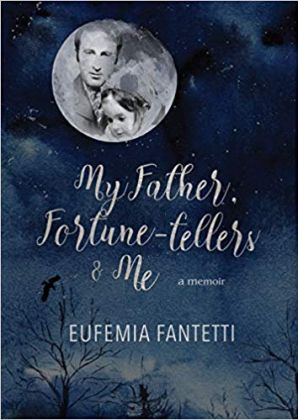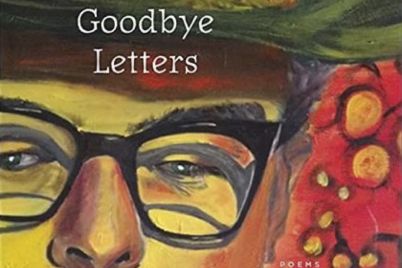Eufemia Fantetti’s most recent book, My Father, Fortune-Tellers & Me: A Memoir (Mother Tongue Publishing, 2019) is a gripping outpouring of grief, confusion, pain, and underlying hope. As the author embarks on an emotionally harrowing journey back to her childhood – to her familial roots in post-World-War II Bonefro, a small mountain town in Southern Italy– we are thrown into an existential tour-de-force. The book’s superb, concise, metaphorical, and brutally honest diction, invites the reader from the opening pages into a private world that is at once frightening, illuminating, humorous, and compelling.
Regardless of how outrageous and acrimonious the circumstances, characters, and dialogue may appear, the veracity of prose and rich detail present us with a plot that unfolds in unfaltering pace and is always believable. Whether we witness Eufemia’s maternal grandmother Sapooch in public trying to strangle her daughter (Eufemia’s mother), or the latter regularly accusing teen-age Eufemia of being a whore, we are always immersed in a human drama that echoes the pulse of our own lapsarian condition.
Euphemia sets the stage for the book’s overarching theme – the vicissitude of fate – by presenting us with the symbolic significance of Tarot cards on one page and a photograph of her parents’ wedding day on the opposite page. This symbiotic introduction – the meaning of trumps, the trionfi, with their emphasis on “The Fool’s Journey,” and the divulging of her parents’ kinship as second cousins (they’d only seen each other twice and had never even spoken to one another before their wedding day) serves as a guidepost for the dark, yet all-too-human odyssey the reader is about to embark on.
My Father, Fortune-Tellers & Me is both a coming-of-age story and the tale of a woman attempting to make sense of her troubled life. The memoir builds meaning through the layering of young Euphemia’s evolving perception of the violent and erratic behaviour of her schizophrenic mother. This inversion of maternal love, this thwarting of the young child’s primordial expectations of nurture, affection and security, create confusion and alarm on her embryonic psyche, etching wounds that plague her into and throughout childhood. Though not understood by her at the time, five- or six-year-old Eufemia is faced with an existential paradox: the very person who is to offer her love and protection becomes the abuser – the defiler – of her innocence. This macabre dance of primal psychic expectations versus the verbal and physical abuse she receives from her mother leads into an increasing mistrust of family, friendships, and love, resulting in two broken marriages and the fetters of insecurity. Even her father, an uncomplicated, hard-working man who works in a meat factory, who loves Eufemia and tries to protect her against her mother’s violence and histrionics, eventually lets her down. He, too, falls prey to the claws of his wife’s mental illness.
At forty-six Eufemia navigates through memory and tries to give order to the emotional and psychological chaos plaguing her life. She sifts through the superstition, gossip, and folklore often heard from her father – old tales from Bonefro – as she searches for a grain of understanding that will explain the confusion and malice saddled onto her family’s history.
Her parents go back to Bonefro with Eufemia as a child, hoping their beloved hometown will, somehow, exorcise the evil playing havoc with their lives. But instead of a panacea, the dreamed-of Shangri-La, they encounter mostly hurt, disillusionment and shame. Except for her paternal grandmother, Femia with the saddest smile, whom Eufemia resembles and who takes Eufemia onto her bosom, most relatives, and acquaintances have been maligned, either by harsh poverty (the Fantetti side) or by a myopic selfishness and ill-will (on her mother’s side).
Eufemia explores her sense of social alienation and estrangement growing up, the outcast mantle she wears as an Italian child growing up in Toronto against the backdrop of an Anglo-Saxon society, whose language, foods, beliefs, customs and histories are alien to her immigrant parents. This sense of displacement – of not fitting in, not measuring up, not being as pretty, as smart, and as self-worthy as other girls her age – becomes the seed of a later crippling depression. Nightmarish nights, sleepy days, missed MFA classes, bleak visions of the future.
In this painful reopening of old-wounds, old stories and family myths, Eufemia forages into her past for answers to the enigma that is shutting the doors to her chance at happiness, an enigma she can’t solve, regardless of the many professionals and Tarot cards she visits. She adeptly reveals the old Southern Italian small town and values through the eyes of the Canadian-born child, turning a harrowing tale, at times, into humour.
As a young adult, Eufemia moves to Victoria in the hope that thousands of miles away from Toronto she will be able to cut the invisible chains binding her to her debilitating parents – the independent, fully realized being she aspires to be, having been, so far, out of reach. To her horror, the ghosts of her wrathful upbringing continue to haunt her. New place, new clothes, new school, new friends, love, but the demons – long ago sprouted in that ancient soil, perhaps even before Christ arrived, before Italy had a name, and cappuccino invented, as Euphemia wittily notes – kidnap her chances of feeling normal.
Considering that Eufemia’s mother is the antagonist – the villain, the engine propelling this familial tragedy forward, and directly or indirectly present in every action – one would expect the title would include the word Mother. That it doesn’t is, at first, suspect. But soon we learn that in such a tightly-woven, well-crafted text, surely there are no mistakes of omissions. It is then that the central idea in the book reveals itself; then that we see that the memoir, fundamentally, delves into the complexity of victimhood and the guilt and calamitous consequences attached to that shackled reality.
On the one hand, Euphemia and her father, both seekers of love and peace, are the victims of her mother’s schizophrenia by being unable to extricate themselves from its far-reaching web. After a few years living in Victoria and Vancouver, Eufemia returns. By now, her parents are divorced, and her mother is living alone in a supervised facility. Still, Eufemia tells us, she sees her mother everywhere.
On the other hand, the mother, too, searches for her daughter at airports, in malls and behind the apartment’s garden bushes. She too is a victim of bad DNA, or bad blood, or just a miserable environment, such as the pressure to marry a stranger, a second-cousin, for pecuniary necessity and to save her honour (she’d been seen cavorting with Gypsies). The irony of Eufemia and her mother, despite all the emotional havoc between them, continuing to seek one another is not lost on the reader
By enmeshing the personal with Southern Italian folklore, superstitions, clairvoyance, classical myth, history, and universal truths, Eufemia invites us to witness and, by extension to participate, in an unfolding drama of Shakespearean proportions. Sophocles’ play Thebes – a motif throughout the book, a metaphorical scaffold, as it were, holding up the Fantetti tragedy – functions as a reminder that we, too, are part of the suffering, the doubt, the confusion, the mystery enmeshed into our own existence.
Ultimately, the book is a desperate odyssey into that dark and vast unknown called life. And here, in this, in Eufemia’s suffering, confusion, pain, and attempt to come to terms with what has happened to her, resides the literary and transformational power of My Father, Fortune-Tellers & Me.




